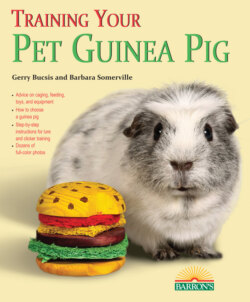Читать книгу Training Your Guinea Pig - Gerry Bucsis - Страница 17
На сайте Литреса книга снята с продажи.
Multi-level cages and extensions
ОглавлениеWhich is better for your cavies: a single-level cage or a multi-story cage? What you don’t want is the traditional multi-story pet condo, which has several levels, each of them having very limited floor space. The ideal guinea pig cage should have as much floor space as possible. Guinea pigs like to run “piggy laps” around the cage, so the more room they have to run around on the main floor, the better. It is, however, perfectly fine to add a second story as long as you provide an adequate lower floor. But if you go this route, there are some safety issues to keep in mind.
In some C&C cage kits, the second story of the cage is the same size as the first story; in other words, it’s a complete floor. But most owners design the second story as a loft that overlooks the first floor. If this is the design you go with, you’ll have to make sure the loft is enclosed or has a barrier along the open side so your cavies can’t fall over the edge onto the floor below.
How do you design a safe second story? There are lots of ways to do this. Your best plan is to search the Internet or browse YouTube. You’ll be amazed at how many innovative designs other enterprising guinea pig owners have come up with. Think you’ve found a blueprint for the perfect second story? Great! Just make sure it will be sturdy enough and safe enough for your cavies.
Your next concern will be how your cavies are going to get up to the second floor. Gently sloping ramps are the way to go here; guinea pigs won’t walk on anything too steep. You can buy ready-made ramps, or you can make them yourself. The most popular ones are constructed from coroplast or from wire grids. If you’re using coroplast, you’ll need to reinforce it. For example, you could duct-tape a piece of wire grid to the back to make the coroplast ramp sturdier. You should also cover it with a piece of fleece or carpet for better traction.
If you’re making a ramp out of a wire grid, use your knee or your foot to bend it into a U-shape; this will provide protective sides for the ramp. You can also bend it into an L-shape. Then, if you place it against an outside cage wall, you will have made a ramp with even higher protective sides. Whatever wire-grid design you choose, be sure to cover the ramp with a piece of low-pile rug or mat. Never let your guinea pigs walk directly on wire because it’s very bad for their feet.
Toys and chewies can be hung on the gird wires of C&C cages.
You could also be creative and use sisal-covered cat-scratching boards as ramps. These can be attached to the upper floor by drilling holes at the top of the scratching board and using zip ties to secure the ramp to the second story.
Some guinea pigs run up and down ramps just fine; others are more timid and might need encouragement. To train a timid cavy, try placing a line of small treats up the ramp and onto the second level. Most guinea pigs will be so focused on the food that they’ll be up the ramp in no time.
If you have plenty of space, why not give your cavies extra romp room by adding a playroom extension to the cage? For an addition like this, all you need is a cheap kiddie pool made of hard plastic, wire grids connected with zip ties to form a fence around the pool, a section of 4-inch (10 cm) diameter PVC piping to join the pool to the cage, and a few paving bricks for steps at either end of the PVC pipe. Instead of a pool, you could always substitute the smaller cage you were using before you switched to a C&C cage.
